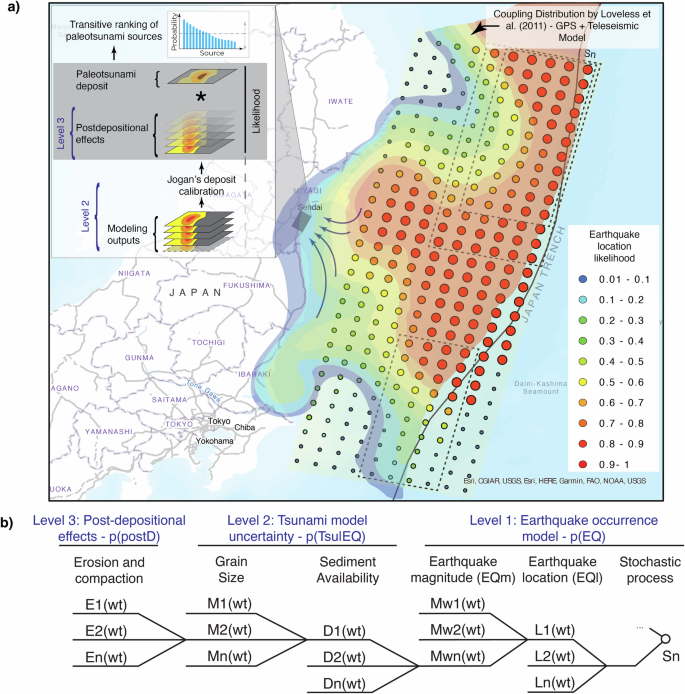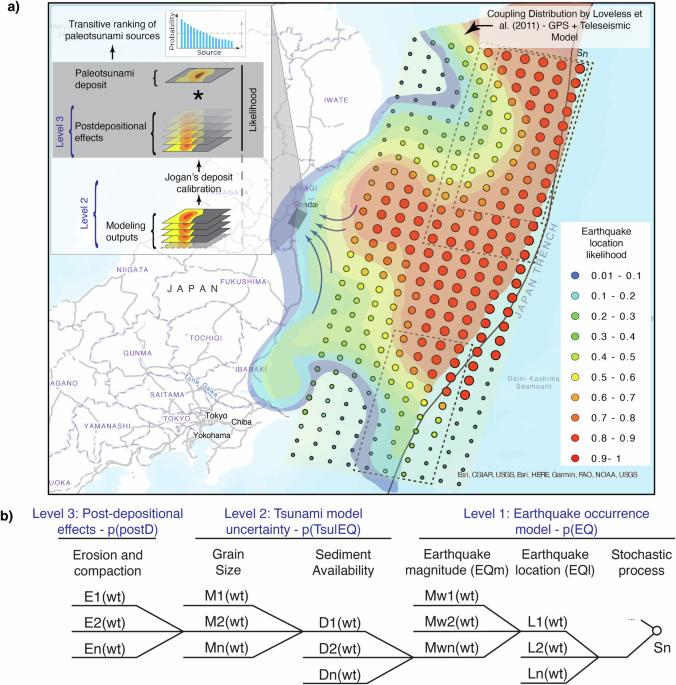利用贝叶斯框架追踪古海啸的源头
IF 8.1
1区 地球科学
Q1 ENVIRONMENTAL SCIENCES
引用次数: 0
摘要
古海啸沉积物为这些事件提供了令人信服的记录,包括对其复发和相关震级的宝贵见解。然而,由于水动力和地质现象之间复杂的相互作用,以及海啸沉积物形成和保存过程的错综复杂性,精确确定这些沉积证据的来源仍然具有挑战性。在这里,我们引入了一种新方法,利用贝叶斯推理方法将复杂的海啸过程划分为若干部分,并独立处理不确定性,从而能够更精确、更全面地建立海啸源模型。我们提供了一个具有不同可能性的潜在地震场景列表,而不是单一的最佳拟合。基于这种方法,我们计算出 869 年鸟干地震的震源在矩震级 8.84 到 9.1 之间(一个标准差以内),沿日本海沟有不同的滑移分布。我们的研究结果再次证实了壶关地震与 2011 年东北地区海啸的震级相似,并提高了古海啸沉积物在灾害评估中的适用性。贝叶斯推理方法可以通过恢复因果源和考虑过程中每一步的不确定性来了解古海啸沉积的来源。本文章由计算机程序翻译,如有差异,请以英文原文为准。


Tracing the sources of paleotsunamis using Bayesian frameworks
Paleotsunami deposits provide a compelling record of these events, including valuable insights into their recurrence and associated magnitudes. However, precisely determining the sources of these sedimentary evidence remains challenging due to the complex interplay between hydrodynamic and geological phenomena and the intricacy of the processes responsible for forming and preserving tsunami deposits. Here, we introduce a novel approach that employs Bayesian inference methods to divide the complex tsunami process into segments and independently handle uncertainties, thereby enabling more precise and comprehensive modelling of the sources. We provide a list of potential earthquake scenarios with different likelihoods instead of a single best fit. Based on this method, we calculated that the source of the 869 Jogan earthquake had a magnitude ranging from Moment Magnitude 8.84 to 9.1 (within one standard deviation) with different slip distributions along the Japan Trench. Our results reaffirm that the Jogan event had a similar order of magnitude to the 2011 Tohoku-oki tsunami and enhanced the applicability of paleotsunami deposits to hazard assessment. Bayesian inference methods can be used to understand the sources of palaeotsunami deposits by recovering the causal source and accounting for uncertainty at each step of the process.
求助全文
通过发布文献求助,成功后即可免费获取论文全文。
去求助
来源期刊

Communications Earth & Environment
Earth and Planetary Sciences-General Earth and Planetary Sciences
CiteScore
8.60
自引率
2.50%
发文量
269
审稿时长
26 weeks
期刊介绍:
Communications Earth & Environment is an open access journal from Nature Portfolio publishing high-quality research, reviews and commentary in all areas of the Earth, environmental and planetary sciences. Research papers published by the journal represent significant advances that bring new insight to a specialized area in Earth science, planetary science or environmental science.
Communications Earth & Environment has a 2-year impact factor of 7.9 (2022 Journal Citation Reports®). Articles published in the journal in 2022 were downloaded 1,412,858 times. Median time from submission to the first editorial decision is 8 days.
 求助内容:
求助内容: 应助结果提醒方式:
应助结果提醒方式:


